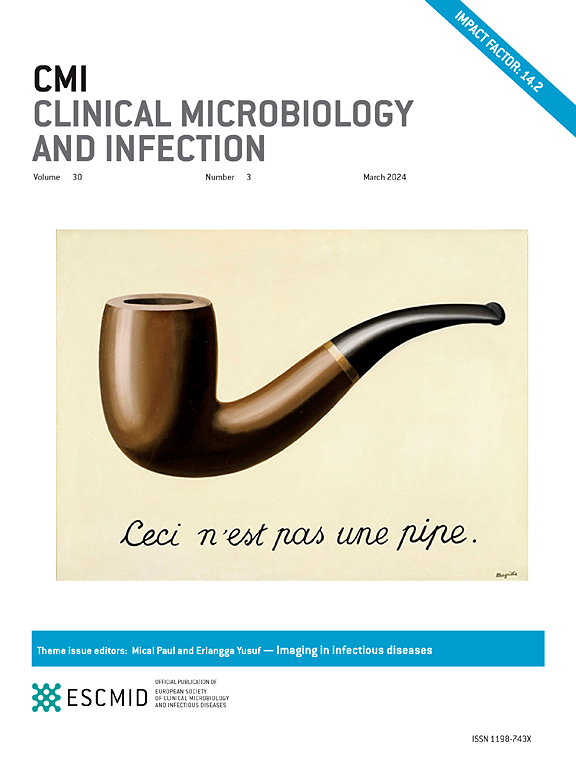直接从梅毒患者临床标本中分离当代梅毒螺旋体菌株。
IF 10.9
1区 医学
Q1 INFECTIOUS DISEASES
引用次数: 0
摘要
目的:苍白螺旋体亚种(T. pallidum)是梅毒的病原体,梅毒是一种具有全球公共卫生重要性的性传播疾病。本研究旨在引入一种新的体外方案,直接从患者的临床样本中分离苍白螺旋体,无需进行家兔繁殖:方法:从捷克共和国布尔诺市两家医院的 9 名无流行病学关联的患者身上采集了 4 份口腔拭子和 5 份生殖器拭子。拭子浸没在 TpCM-2 培养基中进行运输。然后,将样本放在 0.4 μm 过滤器上培养 2.5 小时。在此期间,螺旋形苍白球细胞通过滤孔进入含有 TpCM-2 培养基和兔饲养细胞(Sf1Ep)的孔中。每隔 7 天在新的培养孔中进行一次亚培养,可获得稳定的苍白螺旋体培养物(含 >1 × 107 个三联体):结果:成功建立了体外分离苍白螺旋体的方案。从处理的 9 份临床标本中,经过 14-112 天的培养,得到了 6 株苍白螺旋体培养物(MU1-MU6)。其中五株(MU1-MU5)属于 SS14 样群,具有相同的等位基因特征 1.3.1。其余菌株(MU6)被鉴定为等位基因特征为 9.16.3 的尼科尔斯类菌株:所引入的体外方案可从临床材料(包括冷冻样本)中分离出苍白螺旋体,而无需使用实验兔。这种方法有助于分离当代临床相关的三联体菌株。本文章由计算机程序翻译,如有差异,请以英文原文为准。

In vitro isolation of contemporary Treponema pallidum strains directly from clinical samples of syphilis patients
Objectives
Treponema pallidum subsp. pallidum (T. pallidum) is the etiological agent of syphilis, a sexually transmitted disease of global public health importance. The objective of this study was to introduce a novel in vitro protocol for isolation of T. pallidum directly from patients' clinical samples, eliminating the need for rabbit propagation.
Methods
Four oral and five genital swabs were collected from nine epidemiologically unrelated patients at two hospitals in Brno, Czech Republic. Swabs were submerged in TpCM-2 medium for transport. Samples were then placed on a 0.4 μm filters and incubated for 2.5 hours. During this period, spiral T. pallidum cells passed through the filter pores to the well containing TpCM-2 medium and rabbit feeder cells (Sf1Ep). Stable T. pallidum cultures (containing >1 × 107 treponemes) were achieved by subculturing every 7 days into fresh well.
Results
A successful protocol for in vitro isolation of T. pallidum was established. From the nine clinical specimens processed, six T. pallidum cultures (MU1–MU6) were derived after 14 to 112 days of cultivation. Five of these strains (MU1–MU5) belonged to SS14-like cluster and shared the same allelic profile 1.3.1. The remaining strain (MU6) was identified as a Nichols-like strain with an allelic profile 9.16.3.
Discussion
The introduced in vitro protocol enables isolation of T. pallidum from clinical material, including frozen samples, without the need for experimental rabbits. This method facilitates the isolation of contemporary, clinically relevant treponemal strains.
求助全文
通过发布文献求助,成功后即可免费获取论文全文。
去求助
来源期刊
CiteScore
25.30
自引率
2.10%
发文量
441
审稿时长
2-4 weeks
期刊介绍:
Clinical Microbiology and Infection (CMI) is a monthly journal published by the European Society of Clinical Microbiology and Infectious Diseases. It focuses on peer-reviewed papers covering basic and applied research in microbiology, infectious diseases, virology, parasitology, immunology, and epidemiology as they relate to therapy and diagnostics.

 求助内容:
求助内容: 应助结果提醒方式:
应助结果提醒方式:


